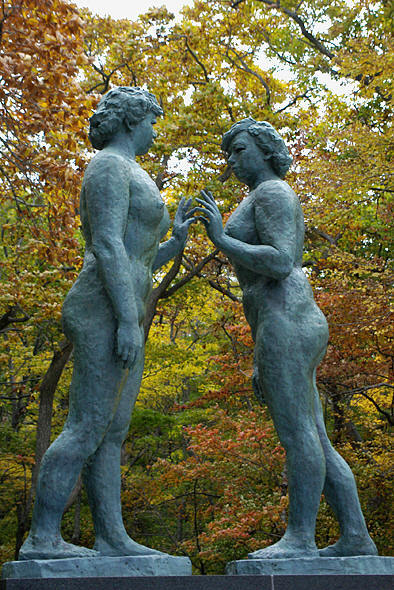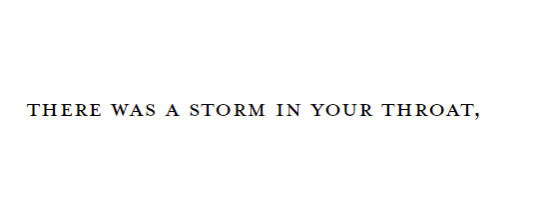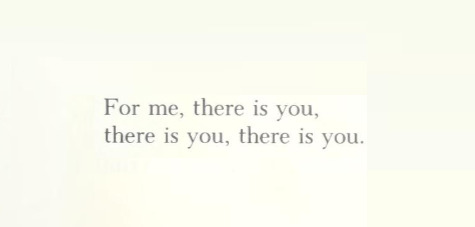#chieko & other poems
Text

Kōtarō Takamura, tr. by Hiroaki Sato, from Chieko & Other Poems; "Black Cat,"
712 notes
·
View notes
Text
"I'm drawn by justice and beauty."
Kōtarō Takamura, tr. by Hiroaki Sato, from Chieko & Other Poems; "The Natural Thing,"
4 notes
·
View notes
Text
"December meant both strength and fury."
Kōtarō Takamura, tr. by Hiroaki Sato, from Chieko & Other Poems; "Two Under the Tree,"
0 notes
Text

Randomly coming back to this blog to point out something I don't think has been pointed out so far(?). But I could be mistaken. Anyway!
The statue drawn in the background of chapter 74's cover is an actual existing statue, called the 乙女の像 (Otome no Zou) or Statue of Maidens in English. It was sculpted by Takamura Kotarou, who is also a poet (that's our man), in 1952 for the Aomori prefecture, specifically the city of Towada and its lake. Meaning, by the way, that Hachirou's temple is near this city.

Source : aptinet.jp
The sculptor was inspired by the clear reflection he saw on the lake's surface, and wanted to express the idea that looking at this lake is like looking at and inside oneself. He sculpted two identical women, "reflecting" one other... You know, a bit like twins!

Source : blowinthewind.net
The way Katou drew it, it looks like the women are holding hands, but they're not in the actual sculpture.
For a bit more on the story; Takamura Kotarou is the son of a famous sculptor, and became a very famous sculptor himself. He even worked with Rodin back in 1909. This statue is his last work, he made a poem about the statue before passing away. The actual model is Fujii Teruko, but many people think the work is also based on Takamura's late wife, Chieko, who died years prior in 1938. The statue was commissioned by the Aomori prefecture to promote three men important to the city and its lake : Omachi Keigetsu, a poet who made the lake famous; Takeda Chiyosaburo, the then-governor of Towada; and Ogasawara Koichi, member of the prefectural assembly.
Source!
Just thought it was interesting to point out, considering the themes of the Aomori arc, and of both twins' character arcs.
61 notes
·
View notes
Note
9,64,66,67,84 for chieko and yasu pls
Thanks for the ask ☺️
9. If they could change one part of their appearance, what would it be?
Yasu wouldn’t come up with anything to change.
Chieko meanwhile would probably want to change something about her figure, in her teen-years at least. She’ll grow more confident as an adult.
64. Describe what their social media would be like.
omg, yes I love things like this
Both of them would probably be urged to create accounts on all of the most important social media websites by Hideyoshi...
Yasu would mainly use Instagram & tumblr though. His account is just full of nature aesthetic posts (photos he took in the forest). They come with the occasional deep quote as well. Yasu himself is rarely seen on any of his photos.
Chieko would also use tumblr the most. Her blog would be a mix of reblogged aesthetics (some of them photos by Yasu, out of solidarity. But also a lot of light/dark academia) and reviews on all the books she read during this month. Occasionally she will also reblog some history-memes. I could also imagine her using twitter rather frequently. Usually to complain or ramble a little about random stuff. The only platform she’d post pictures of herself on is Instagram, which is also locked in her case, but she does not go there too often.
66. What nicknames do others call them by?
Yasu is called “Big Brother” by a lot of the younger residents at Polar Star.
Chieko is called “Chi-chan” by Yasu ever since they’re tiny. Shigeo also occasionally calls her “Marui-darling”.
67. What’s an outrageous story about them nobody believes?
The Polar Star Quartett once snuck on a party for that was strictly for upperclassmen. Hideyoshi, Daisuke and Chieko were all drunk when deciding on this. Yasu followed along to prevent the worst.
Chieko’s most embarrassed by it.
84. What’s one thing they like that they don’t want anyone to know about?
For Yasu, it’s his hobby of writing poems or actual song texts whenever feelings overwhelm him. The only one who is allowed to get a glimpse on them once in a while is Chieko but even with her, he’s shy about it.
For Chieko it’s Shigeo Eizan, lol her secret enjoyment of Otome Games.
2 notes
·
View notes
Text
Japanese Practice 94
Original:
最近、翻訳の授業に「冬が来た」という日本の詩を読んで英語に翻訳しました。この詩は高村光太郎に書かれました。詩の翻訳はなかなか難しいですが、楽しいと思います。「冬が来た」がとても気に入りました。高村光太郎に書かれた「智恵子抄」のような他の詩も読みたいです。
______________________________
Revised:
最近、翻訳の授業で「冬が来た」という日本の詩を読んで、英語に翻訳しました。この詩は高村光太郎によって書かれました(OR: の作品です)。詩の翻訳は一筋縄ではいかないものですが、楽しいと思います(OR: 楽しいです)。「冬が来た」がとても気に入りました。高村光太郎によって書かれた「智恵子抄」のような他の詩も読みたいです。(OR:「智恵子抄」のような高村光太郎が書いた他の詩も読みたいです。)
______________________________
English:
Recently in my translation class, we read and translated into English the Japanese poem "Winter has come". This poem was written by Takamura Koutarou. Translating poetry can be challenging, but I think it's fun. I really liked "Winter has Come". I would like to read other poems written by Takamura Koutarou too, like the Chieko poems.
______________________________
Analysis:
一筋縄ではいかないもの = to be hard to deal with, not straightforward
で particle vs. に particle:
で = locative particle when used with an action verb
に = location particle when used with verbs 行く、ある
によって= by
11 notes
·
View notes
Text
Listen to an old Japanese song Hokkiko/Carlos Pueblo
Recently, I am back to Japanese language study; therefore, I switch my
You Tube attention from Richard Clayderman’s piano pieces to the old
Japanese Enka and I am introducing one of them, Kokkiko, amended in
1961 for a movie of Kobayashi Akira originally by Oda Hirosi in 1941 at
Lushun, Manchuko. It was very popular among students who resided at
the dormitory of Lushun Koutougakkou. I need to explain more about the
old school system in Japan before 1945. My alma mater, Taiwan Normal
University, has been on the campus of Taihoku Koutougakkou established
in 1927. My father mentioned this institution when I passed the entrance
examination to enter Taiwan Normal and briefly about the status at that
time.
Oda was 19 when he enrolled to the school just open in 1941. He was born
In 1922; therefore, my conclusion was that he missed his application to be
a freshman at Tokyo First Koutougakkou, Ichi Ko for short which he mentioned
his sorry on the poem at paragraph 2 of the original poem. He also mentioned
the Manchuko University, Chien Kuo Daigatko, on the same sentence and of
course Lu Kou. The whole piece is very touching of his time wondering from
the imperial capital city of Tokyo and came to Manchu outside of Japanese
homeland. He did use the bitter sake, misery rain, separation of family and
friends to complete his homesick. The song was very popular at that time
with his pier. After the War, people are still singing it, of course, Kobayashi
made it famous and so do many other famous singers which I’ll name a few,
Baisho Chieko, Chiaki Naomi, Doji Yukiko, Miyoshi Eiji, Ishikawa Sayuri, etc
for the amended edition Hokikko while the original one under the performance
of Midorizaki Kasumi, the dormitory song of Lu Kou.
I was brought up by Japanese music after the War due to the vacuum of
Chinese occupation in Taiwan. I have never get into the Chinese music such
as classical Mandarin Opera or any kinds of instrument used. I believe that
the Meiji Restoration and the acceptance of the western civilization makes
the difference of Japan from China. I am interested in songs making and
the Pro-Prussian school systems. Now, in Japan is 6-3-3-4 schools like the
U.S. while before the War, 5-5-3-3 and Koutougakkou is the first 3 and the
final three is the university, Imperial University or Private University. I
believe the old British school systems are identical and I suspect the Eaton
and Rugby school are Koutougakkou. The Oxford and Cambridge were 3
years term then.
0 notes
Text

Kōtarō Takamura, tr. by Hiroaki Sato, from Chieko & Other Poems; "Us,"
#lit#kotaro takamura#poetry#eternity#love#gorgeous gorgeous line#us#chieko & other poems#poetry in translation#p
541 notes
·
View notes
Text

Kōtarō Takamura, tr. by Hiroaki Sato, from Chieko & Other Poems; "The Natural Thing,"
227 notes
·
View notes
Text

Kōtarō Takamura, tr. by Hiroaki Sato, from Chieko & Other Poems; "The Natural Thing,"
291 notes
·
View notes
Text

Kōtarō Takamura, tr. by Hiroaki Sato, from Chieko & Other Poems; "Chieko Riding the Wind,"
#lit#kotaro takamura#poetry#words#quotes#selections#morning#fragments#chieko & other poems#writings#p
96 notes
·
View notes
Text

Kōtarō Takamura, tr. by Hiroaki Sato, from Chieko & Other Poems; "Two Under the Tree,"
#lit#kotaro takamura#poetry#writings#words#poetry in translation#selections#fragments#excerpts#quotes#p#winter
4K notes
·
View notes
Text

Kōtarō Takamura, tr. by Hiroaki Sato, from Chieko & Other Poems; "Two Under the Tree,"
1K notes
·
View notes
Text

Kōtarō Takamura, tr. by Hiroaki Sato, from Chieko & Other Poems; "To General Kuribayashi,"
483 notes
·
View notes
Text

Kōtarō Takamura, tr. by Hiroaki Sato, from Chieko & Other Poems; "Lemon Elegy,"
782 notes
·
View notes
Text

Kōtarō Takamura, tr. by Hiroaki Sato, from Chieko & Other Poems; "Fountain of Mankind,"
#lit#kotaro takamura#poetry#writings#words#japanese literature#fragments#fountain of mankind#selections#p
565 notes
·
View notes